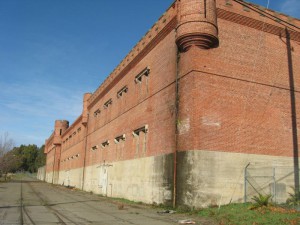by Frances Dinkelspiel
1) The Franciscan Fathers of Baja California
The Franciscan fathers were the first to plant grapes for California wine. Father Junipero Serra wrote to his bosses in Baja California in the late 18th century and asked that they ship grapevines north. The grapes were planted at Mission San Juan Capistrano near Los Angeles. They were named Mission grapes and became the primary grape used for making wine throughout the 1880s, even though the wine they produced was flat and bland. Historians think the first harvest in California was in 1782

headquarters building in San Francisco. The building was destroyed in the earthquake
and fire of 1906. (From a California Wine Association brochure, c. 1910; Huntington Library). Image is in the public domain via Publishing.cdlib.org
2) Early California Wine
Southern California, not Napa or Sonoma, was the heart of the early wine industry in the 19th century. Settlers in the pueblo of Los Angeles, including Californios, Americans, and Frenchmen, planted vineyards along the banks of the Los Angeles River. In the 1870s, there were so many grapevines that Los Angeles was nicknamed the “City of Vines.” A disease had wiped out most of the grapevines by 1886. Urbanization did the rest.
3) San Francisco Explodes
The action moved to San Francisco in the 1890s, when wine houses – large operations that bought grapes, made wine, and shipped it around the world – dominated the industry. San Francisco’s temperate climate, with its summers cooled by fog, made it an ideal place to store wine. By the 1890s, there were more than 100 wine houses in the city.
4) The California Wine Association Monopoly
In 1894, after the price for wine and grapes hit rock bottom, seven of these wine houses merged to form the California Wine Association to stabilize the market. After a bruising and brutal wine war, the CWA became a monopoly, eventually controlling 80% of the production and distribution of wine in California.

Image is in the public domain via cfspm.org
5) The World’s Largest Winery
After the 1906 earthquake and fire in San Francisco, the California Wine Association built the world’s largest winery on Pt. Molate near Richmond. (See photo above.) Winehaven was a city-state, with housing for workers, a school, a big house for the boss, train tracks, a port, and the capacity to store 10 million gallons of wine at once. It is still there, decaying on the edge of the bay. You can see it to your left as you drive east across the Richmond-San Rafael Bridge.
FRANCES DINKELSPIEL is passionate about the history of California wine. She is an award-winning journalist and the author of TANGLED VINES Greed, Murder, Obsession, and an Arsonist in the Vineyards of California and Towers of Gold: How One Jewish Immigrant Named Isaias Hellman Created California. Towers of Gold was a San Francisco Chronicle bestseller and named a Best Book of the Year by the Chronicle and the Northern California Independent Booksellers Association. She is the co-founder of the news site Berkeleyside and her articles have appeared in the New York Times, the Wall Street Journal, Los Angeles Times, People, San Francisco Magazine, and other venues. She lives in Berkeley, California.
